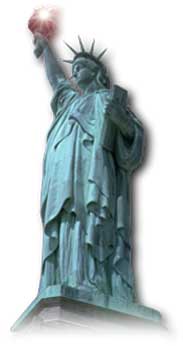|
|
|
 |
|
|
U.S.
Society > A Nation of Immigrants |
|
The Golden Door Limits on Newcomers Illegal Immigrants The Legacy
Immigrants also enrich American communities by bringing aspects of their native cultures with them. Many black Americans now celebrate both Christmas and Kwanzaa, a festival drawn from African rituals. Hispanic Americans celebrate their traditions with street fairs and other festivities on Cinco de Mayo (May 5). Ethnic restaurants abound in many American cities. President John F. Kennedy, himself the grandson of Irish immigrants, summed up this blend of the old and the new when he called America "a society of immigrants, each of whom had begun life anew, on an equal footing. This is the secret of America: a nation of people with the fresh memory of old traditions who dare to explore new frontiers.... " |
|||||||
| Feature Articles | |||||||
Refugee
Resettlement in the United States New
Immigrants Live Russian and American Lives A
Patchwork Culture - Identity in America
Multicultural
Literature in the U.S.Today (Electronic
Journal, February 2009) American
Olympic Team Reflects U.S. Diversity. By Domenick DiPasquale.
America.gov, July 30, 2008. U.S.
Minority Population Continues to Grow. By David Minckler.
America.gov, May 14, 2008. Ellis
Island Honors Immigrants to United States. By Melody
Merin The
Immigration Act of 1965: Intended and Unintended Consequences.
By Roger Daniels. |
|||||||
| Texts
are abridged from U.S. State Department IIP
publications and other U.S. government materials. |
|||||||
DISCLAIMER
Any reference obtained from this server to a specific commercial product, process, or service does not constitute or imply an endorsement by the United States Government of the product, process, or service, or its producer or provider. The views and opinions expressed in any referenced document do not necessarily state or reflect those of the United States Government. |
 U.S. Diplomatic Mission to Germany /Public Affairs/ Information Resource Centers Updated: October 2010 |


